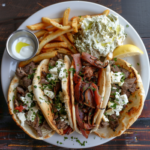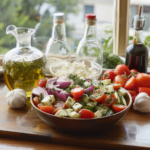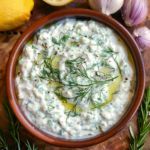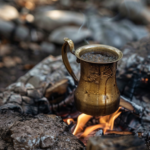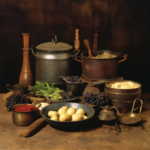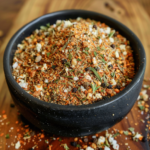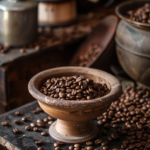Anthony Bourdain on Crete discovers Staka

Anthony Bourdain: In an unexpected turn during my culinary travels, I encountered a dish I had never seen before—a dip called staka, crafted from the butterfat of goat’s milk. This intriguing dish is slowly warmed and thickened with flour until it transforms into a solid mass, pulling cleanly away from the sides of the pot.
Anthony Bourdain: The local chef, a man steeped in tradition, makes the sign of the cross before preparing staka, hoping for a blessed result. This ritual, deeply rooted in his culture, underscores the reverence and care put into traditional cooking.
Anthony Bourdain: Staka intriguingly defies the foundational principles of French gastronomy. Ordinarily, the idea of adding raw flour directly to dishes is a culinary faux pas, but here it becomes the backbone of a unique and delicious creation. This preparation is starkly different from the Greek cuisine I’ve sampled in New York diners, which had led me to expect something entirely different.
Anthony Bourdain: This meal was a revelation, starkly different and stunningly good, contrasting sharply with the oft-overlooked simplicity of true Greek cuisine. It’s a testament to the dishes that have sustained generations and contributed to the renowned longevity of the Greeks. Among these, the famous greens stand out—they’re not just food; they’re a lifeline.
Anthony Bourdain: “Absolutely, this is my favorite dish,” I confessed as we shared the meal, appreciating the flavors that define this vibrant cuisine. The staka, especially, was a revelation. Delicious and defiant of culinary norms, it’s a dish that’s both simple and outrageously good.
Anthony Bourdain: Yamas! Here’s to a good meal and the delightful surprises of Greek cooking—simple, straightforward, and prepared in a family setting. This experience reminded me of the power of humble ingredients and traditional methods in creating extraordinary meals.
Here’s how you can make (Anthony Bourdain) Staka at home:
Ingredients:
- 2 cups of fresh cream from sheep’s or goat’s milk (you can also use heavy cream as a substitute)
- 1-2 tablespoons of all-purpose flour
- Salt to taste
- Optional: a few drops of lemon juice or vinegar to add a slight tang
Instructions:
- Prepare the Cream:
- If you’re using fresh cream from milk, let the milk sit for a few hours until the cream rises to the top. Carefully scoop the cream off the top.
- Heat the Cream:
- In a non-stick pan, gently heat the cream over low heat. The key is to warm it slowly to prevent burning, as the milk solids can stick to the bottom of the pan and scorch.
- Add Flour:
- Sprinkle the flour over the cream, whisking constantly to prevent lumps. The amount of flour you add can vary depending on how thick you want your staka. Start with one tablespoon and add more if needed.
- Continue Cooking:
- Keep stirring the mixture slowly and continuously. As the cream heats, it will start to thicken. Keep the heat low to allow the flour to cook without the mixture coming to a boil.
- Season:
- Once the mixture reaches a thick, creamy consistency (similar to a bechamel sauce), add salt to taste. If you like, a few drops of lemon juice or vinegar can be added to cut through the richness.
- Serve:
- Remove from heat. Staka is traditionally served warm. It can be poured over boiled potatoes or served alongside bread. It’s also delicious over steamed vegetables or with poached eggs.
Tips:
- Stirring is crucial: Continuous, gentle stirring is important to prevent the staka from sticking to the pan and to ensure it cooks evenly.
- Adjust thickness: The thickness of staka can vary based on personal preference. Adjust the amount of flour or cooking time to achieve your desired consistency.
This recipe gives you a taste of traditional Cretan cuisine, showcasing the simplicity and richness of local ingredients. Enjoy making and savoring your own staka!
FAQ: Making and Enjoying Staka that Anthony Bourdain ate
Q1: What is staka? A1: Staka is a traditional Cretan sauce made from the cream of sheep’s or goat’s milk, thickened with flour and seasoned lightly. It has a rich, creamy texture and is used in various ways in Cretan cuisine.
Q2: Can I use cow’s milk cream instead of sheep’s or goat’s milk cream? A2: Traditionally, staka is made from sheep’s or goat’s milk because of its higher fat content and distinct flavor. However, if these are not available, you can use heavy cream from cow’s milk as a substitute.
Q3: What does staka taste like? A3: Staka has a very rich and creamy taste, with a slight tang if lemon juice or vinegar is added. The flavor is predominantly milky and buttery, with a comforting, velvety texture.
Q4: How is staka traditionally served? A4: Staka is typically served warm over boiled potatoes, with rustic bread, or as a side sauce for various dishes. It can also accompany vegetables, rice, or eggs.
Q5: Is that staka Anthony Bourdain ate similar to any other dishes? A5: Staka can be compared to a roux-based sauce in terms of texture but is unique in flavor due to its use of unpasteurized sheep’s or goat’s milk cream. Its preparation method is similar to making traditional butter sauces but with the inclusion of flour.
Q6: How long does it take to make staka? A6: The preparation time for staka is relatively short, about 15-20 minutes. However, it requires constant attention and stirring to ensure it does not burn or stick to the pan.
Q7: Can staka be stored for later use? A7: Staka is best enjoyed fresh but can be refrigerated for 1-2 days. Reheat gently over low heat, adding a little milk or water if it has thickened too much upon cooling.
Q8: Are there any common variations of staka? A8: Some variations include adding eggs to the sauce to make a richer version, known as “stakopsomo,” which is often eaten with bread. Another variation is adding a few drops of lemon juice or vinegar to provide a slight acidity that balances the richness of the milk cream.
Q9: What are the nutritional aspects of staka? A9: Staka is high in fat due to the use of concentrated milk cream. It’s a rich source of dairy fats and calories, making it a hearty addition to meals but should be consumed in moderation, especially by those watching their fat intake.
Q10: Is staka gluten-free? A10: Staka is traditionally made with flour, so it is not gluten-free. However, you could substitute the flour with a gluten-free thickening agent if required.
These FAQs aim to cover essential aspects of making and enjoying staka, giving both novices and experienced cooks valuable insights into this unique and traditional Cretan dish.
About Anthony Bourdain
Anthony Bourdain was a celebrated chef, author, and television personality known for his profound influence on the culinary world and his passionate exploration of global cultures through food. Born in 1956, Bourdain rose to fame with his bestselling book “Kitchen Confidential,” which provided a candid and often irreverent look at the restaurant industry. Anthony Bourdain became a cultural icon with his television shows, including “No Reservations” and “Parts Unknown,” where he traveled to lesser-known parts of the world, engaging with locals and showcasing how food can serve as a bridge between cultures. Anthony Bourdain’s unique storytelling style, combined with his advocacy for authentic, sustainable, and humane culinary practices, earned him respect and admiration worldwide. His sudden passing in 2018 left a profound void in the culinary community, but his legacy continues to inspire curiosity, adventure, and a deeper appreciation for the diverse tapestry of human life.
Chef on a Bike: Your Beacon in the Odyssey of Greek Culinary Exploration”
Chef on a Bike is more than a platform; it embodies a vibrant community where the zeal for Greek culinary traditions is nurtured and celebrated. As you step into our realm, you’re enveloped in an atmosphere enriched with the affection for hearty Greek meals, the invigorating aroma of fresh herbs, and the camaraderie encapsulated in sharing a meal. Our mission, although simple, resonates deeply; it’s about bridging the culinary journey between the novice and the seasoned cook, melding ancient traditions with contemporary twists, and creating a warm enclave for Greek cuisine aficionados and the comforting ambiance of a Greek kitchen. Our platform unveils a treasure trove of authentic recipes, enlightening narratives, and interactive cooking sessions helmed by passionate Greek chefs, whose every stir, chop, and simmer encapsulates the heart of Greek culinary ethos.
Proudly Sponsored by Digital Marketing Company Digital Heroes Caffe and Financial Navigator 360, this venture transcends beyond honing culinary skills, it weaves a narrative venerating the opulent heritage of Greek gastronomy. Today, we unveil the quintessential Greek Spanakopita Recipe, a savory pastry revered in Greek culinary lore. Through the ethos of Chef on a Bike, each recipe transcends beyond mere meal preparation; it’s a voyage into the rich tapestry of Greek culture, traditions, and the communal camaraderie intrinsic in the act of cooking and dining together. Our collaboration with Digital Heroes Caffe and Financial Navigator 360 amplifies our aspiration to share the culinary magnificence of Greece with a global audience, transforming every kitchen into a quaint Hellenic haven.
References:
- My Greek Dish – A hub for authentic Greek recipes.
- The Mediterranean Dish – Offering a variety of Greek and Mediterranean recipes.
- The Greek Foodie – Delve into Greek culinary traditions through various recipes.
- RecipeTin Eats – Explore a plethora of global recipes including Greek favorites.
- Vicki’s Greek Recipes – A collection of cherished Greek recipes from a seasoned cook.
- Lemon Blossoms – Discover a mix of recipes including Greek-inspired dishes.
- Souvlaki For The Soul – A modern take on classic Greek recipes.
- My Sweet Greek – Indulge in Greek culinary traditions through a variety of recipes.
- Olive Tomato – A blend of Greek and Mediterranean recipes aimed at a healthy lifestyle.
- Akis Petretzikis – The official website of Greek chef Akis Petretzikis offering a treasure trove of Greek recipes.
Each of these websites serves as a unique vessel to navigate the vast and rich culinary seascape of Greece, enhancing the holistic experience of delving into Greek cuisine

